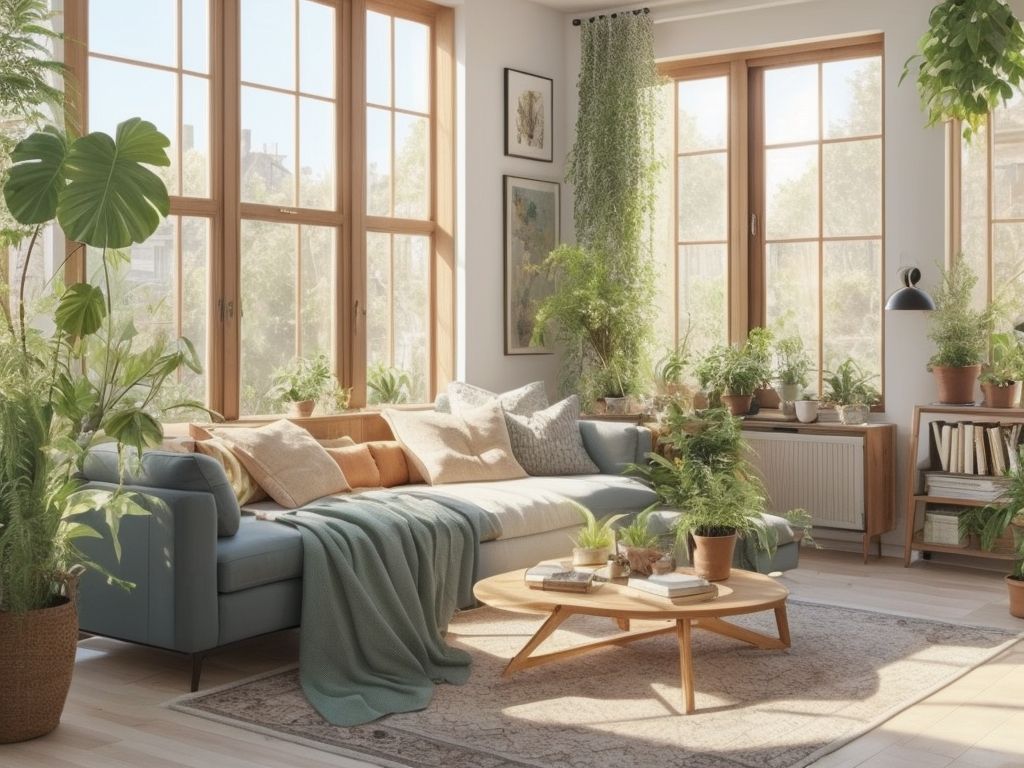Passive solar heating is a way of utilizing the sun’s energy to warm a house naturally. Homes with this heating system usually have specific features that make the most of sunlight exposure and heat keeping, while cutting down heat loss.
For example, big south-facing windows are often seen in these homes. They let plenty of sunlight enter during the day, warming up the inside of the house. Moreover, materials like concrete or stone are used to build the structure or as interior finishes. These materials gather and store heat from the Sun during the day and release it at night when necessary.
Also, to boost energy efficiency, passive solar homes might have shading devices such as overhangs or awnings. These help prevent too much heat gain in summer months when the sun is higher in the sky. Furthermore, insulated walls, roofs, and floors help to reduce heat loss in colder periods.
It’s important to note that having passive solar heating features in a home can significantly reduce energy usage and consequently, lower utility bills. As per the U.S. Department of Energy, passive solar buildings can save 50-80% energy compared to conventional construction methods.
What is passive solar heating?
Passive solar heating is a way to use the sun’s energy for warmth without machinery. It relies on a building’s design and materials to capture, store, and distribute heat.
Orientation matters. Houses should be placed to get sunlight in winter and block it in summer. Large windows or glazing let sunlight in. Thermal mass can absorb and store this heat.
Shading elements like awnings prevent overheating. Insulation is important to stop heat loss. Insulated homes need less heating sources.
Thermal curtains and blinds also help. They insulate windows further.
This kind of heating helps the environment and saves energy. It also saves money in the long run.
Benefits of passive solar heating in a home
Passive solar heating in a home offers a range of advantages. It uses natural sunlight to reduce energy use and costs. It can also improve air quality by cutting back on conventional heating systems. Furthermore, it distributes heat evenly and adds aesthetic appeal with its design features.
- Energy Efficiency: Solar heating provides warmth without needing mechanical systems, meaning lower energy consumption.
- Cost Savings: Natural sunlight replaces fossil fuels and electricity, helping save money.
- Environmental Sustainability: Solar heating reduces emissions and fights climate change.
- Improved Air Quality: Forced-air systems can spread dust and allergens, but passive solar heating stops this.
- Aesthetic Appeal: Big windows and natural light make homes look more inviting.
Moreover, materials like concrete or tile flooring absorb heat during the day and let it out at night. Proper insulation like double-glazed windows or walls and roofs with higher levels of insulation also maintain consistent temperatures.
To get the most out of passive solar heating, consider these tips:
- Window Placement: Put windows on south-facing walls to let in sunlight in winter and provide shade in summer.
- Insulation: Use high-quality materials and techniques to minimize heat loss.
- Thermal Mass: Add thermal mass materials like concrete or stone floors to absorb and store heat.
- Ventilation: Install ventilation to control air quality and prevent overheating.
- Professional Design: Consult with experts to ensure your home is optimized for solar heating.
By following these steps, homeowners can benefit from passive solar heating. Enjoy a comfortable living environment and reduce your carbon footprint!
How does passive solar heating work?
Passive solar heating uses the energy from the sun to heat homes. Sunlight passes through windows and is absorbed by materials such as concrete or stone. This radiates heat into the house without electricity or mechanical systems.
Design a home with passive solar heating to get the most out of it. Large south-facing windows let in more sunlight, thermal mass materials like concrete or tile store heat, and shading devices like awnings or overhangs stop too much heat in warmer months.
Advanced passive solar techniques are also possible. Solar chimneys let hot air escape from the top and draw in cooler air from lower openings. This helps regulate temperature without artificial cooling systems.
This idea is ancient. Greeks, Romans, and Native Americans designed and built with sunlight exposure and thermal mass in mind. Sustainable architecture today is influenced by this ancient wisdom.
Passive solar heating techniques and technologies
Passive solar heating employs three main techniques:
- Direct Gain – maximizes solar gain through strategically placed windows and thermal mass materials that absorb and store heat.
- Indirect Gain – solar heat is collected in a sunspace or Trombe wall and distributed to living areas by convection or radiation.
- Isolated Gain – solar energy is captured in a separate area, such as a greenhouse or solarium, and transferred to the home.
Plus, there are solar water heaters that use solar collectors to heat water. No complex machinery is needed; it’s all about design principles that maximize natural lighting and heat absorption/distribution. Passive solar heating has been around for thousands of years – ancient cultures used windows, masonry walls, and underfloor heating. Nowadays, with tech and design advances, it’s still an effective way of reducing energy consumption while staying comfortable.
Case studies of homes with passive solar heating
Large south-facing windows are a key component of passive solar homes. They maximize exposure to the sun’s rays. Thermal mass materials such as concrete, stone, and brick absorb and store heat, while overhangs or shading devices block direct sunlight in the summer months. Solar collectors can be installed on roofs or walls, transferring heat directly into the home. Proper insulation and airtightness are also essential.
In some cases, special design considerations are used. These include orientation based on local climate, low emissivity windows, thermal curtains and blinds, and integration with renewable energy systems.
Norway has long used passive solar heating in its architecture. Homes are built facing south, with large windows to give them warmth and comfort during long, harsh winters. This success has inspired sustainable building practices around the world.
Tips for implementing passive solar heating in a home
Passive solar heating is a great way to make use of the sun’s energy and stay warm at home. Here are some tips on how to do it:
- Make sure your windows are facing southward. This allows the most sunlight in, especially in winter.
- Get windows with low-emissivity coatings. This helps to keep warm air inside.
- Use thermal mass materials like concrete or brick. These absorb heat from the sun and slowly release it when it’s colder.
- Think about adding a greenhouse or sunroom. These can capture sunlight to transfer heat into other rooms.
- Use natural ventilation. Place windows and vents all around the house to reduce the need for air conditioning.
You can also use thermal curtains and blinds to insulate windows at night or on cloudy days.
Passive solar heating reduces the need for traditional heating, lowers energy costs and is good for the environment. A study by NREL found that homes with passive solar heating can save up to 50% on their energy bills.
Not only does passive solar heating save money, but it’s also an important step towards a more sustainable future. So why not give it a try?
Conclusion
Passive solar heating is an energy-efficient and sustainable way to heat a home. By using the sun’s natural warmth, homes with this feature can reduce their need for traditional heating. These homes typically have big south-facing windows, thermal mass materials, and insulation.
In addition, they may also be equipped with adjustable shading devices to regulate sunlight entering the space, or solar water heaters to provide hot water with renewable energy. Homes with passive solar heating prioritize energy conservation, often featuring systems such as heat recovery ventilators for efficient air circulation.
An important characteristic of these homes is their orientation. To absorb the most sunlight during winter, they are usually positioned so that their longest side faces south. This maximizes sunlight exposure, helping to naturally heat the interior.
A family living in a cold climate highlighted the benefits of passive solar heating. Despite freezing temperatures outside, their home was still warm without needing to use conventional heating systems. They credited this comfort to their passive solar design, which capitalized on the sun’s energy to make a cozy living environment.
Additional resources and references
Books can give comprehensive information about passive solar heating: design principles, implementation techniques, and case studies.
Research papers have data about passive solar heating systems in various climates.
Online forums and communities are great to gain knowledge from experts and other enthusiasts.
Furthermore, organizations that specialize in sustainable architecture or energy-efficient building practices can help with reports, guidelines, and technical documents.
Experience is key too – one can visit homes with passive solar heating or attend workshops.
It’s important to cross-reference info from various sources for accuracy.
Frequently Asked Questions
1. What is passive solar heating?
Passive solar heating is a method of heating a building using the sun’s energy without the need for mechanical or electrical systems. It utilizes design elements and materials that allow for the absorption, storage, and distribution of solar heat.
2. How does passive solar heating work?
Passive solar heating works by utilizing specific building design features to capture and store solar energy. These features include south-facing windows, thermal mass materials, insulation, and proper ventilation. The windows allow sunlight to enter and heat the thermal mass materials, which then release the stored heat gradually.
3. What are the advantages of passive solar heating?
Passive solar heating has several advantages. It reduces energy consumption and reliance on traditional heating systems, resulting in lower utility bills. It also provides a more sustainable and eco-friendly heating solution. Additionally, passive solar heating can enhance comfort by maintaining a consistent and even temperature throughout the home.
4. What are the key components of a home with passive solar heating?
A home with passive solar heating typically includes south-facing windows that allow for maximum solar exposure. The windows are often combined with shading devices to control the amount of sunlight entering the home during different seasons. Thermal mass materials, such as concrete, brick, or tile, are used to store and release heat. Adequate insulation and ventilation systems are also important to ensure efficient heat distribution.
5. Does passive solar heating work in all climates?
Passive solar heating can be effective in a wide range of climates, but the design and implementation need to be adapted accordingly. In colder climates, additional insulation and high-performance windows may be necessary, while in hotter climates, proper shading and ventilation become more important. Overall, passive solar heating can be customized to suit different climates and locations.
6. Can an existing home be retrofitted with passive solar heating?
Yes, it is possible to retrofit an existing home with passive solar heating, although it may require some modifications and additions. Adding south-facing windows, improving insulation, incorporating thermal mass materials, and updating ventilation systems are some of the retrofitting options. Consulting with a professional in solar heating or architecture is recommended for the best results.
Related posts:
- How Much Does Solar Increase Home Value? | Zillow Insights
- How Much Do Home Solar Panels Cost? A Complete Guide to Solar Panel Prices
- Determining the Perfect Size: How Much kW Solar Panel is Required for Your Home
- How Many Solar Panels to Power Home? A Comprehensive Guide on Calculating Solar Panel Requirements



